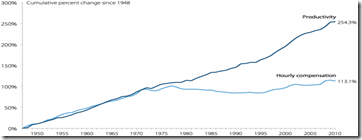Financial FAQs
Corporate profits are at all-time highs, and workers compensation at all-time lows, as fast food workers continue to strike for higher minimum wages. Yet business interests still maintain maximum profits have to be a corporation’s primary consideration. In fact, it would be breaking their corporate charters to operate otherwise!
Actually, not so. Maximizing corporate profits at the expense of everything else—such as environmental pollution—is no longer allowed. And workers have some protections, such as safety regulations under OSHA, and limitations on the number of work hour’s minimum compensation. Then why has the glorification of profit maximization enriched stockholders and CEOs, but not their employees?
One answer is the resistance of businesses to raising the minimum wage. Some states have raised the minimum wage, such as California, and cities such as Seattle. But it’s still $7.25 per hour for most states. This is even though many studies show that higher wages create greater prosperity overall. For instance, Australia, where the minimum wage for adult, full-time workers is $16.87 per hour, currently has a 3.1 percent annual GDP growth rate, vs. 2.5 percent in the U.S.
Nobelist Joseph Stiglitz, an advocate of greater income equality has said, “Our current brand of capitalism is an ersatz capitalism. For proof of this...we have monopolies and oligopolies making persistently high profits. C.E.O.s enjoy incomes that are on average 295 times that of the typical worker, a much higher ratio than in the past, without any evidence of a proportionate increase in productivity.”
The hourly compensation of a typical worker grew in tandem with productivity from 1948–1973. But after 1973, productivity grew strongly, especially after 1995, while the typical worker’s compensation was relatively stagnant. This divergence of pay and productivity has meant that many workers were not benefitting from productivity growth—the economy could afford higher pay but it was not providing it.
A new survey of Harvard Business Alumni by the Harvard Business School entitled A Troubling Divergence in the U.S. Economy highlighted several of the reasons. Business leaders in America are reluctant to hire full-time workers. Instead, many prefer investing in technology to perform work, outsourcing to third parties, or hiring part-time workers. Only 27 percent of respondents reported that their firms engage with institutions like community colleges to prepare students with workforce skills.
And when it comes to updating the public infrastructure that would support greater productivity, forty-two percent of Business School respondents reported that the condition of infrastructure like airports, ports, and roads had declined over the past three years. For every respondent who thought infrastructure had improved, nearly five felt it had worsened.
In fact, private sector growth has been lacking in both job creation and investment in plants and equipment over the past 5 years since the official end of the Great Recession. Private sector capital stock, at 22 years of age, is the oldest it has been since 1958, said economist David Rosenberg, and is strongly suggestive of an upgrade cycle (not to mention the fact that America's spending on public infrastructure at a 20-year low!).
The Calculated Risk graph pictures public sector jobs of both the national and state governments. It grew during Mr. Carter's term (up 1,304,000), during Mr. Reagan's terms (up 1,414,000), during Mr. G.H.W. Bush's term (up 1,127,000), during Mr. Clinton's terms (up 1,934,000), and during Mr. G.W. Bush's terms (up 1,744,000 jobs).
However the public sector has declined significantly since Mr. Obama took office (down 682,000 jobs). These job losses have mostly been at the state and local level, but more recently at the Federal level. Needless to say, this has been a significant drag on overall employment.
Is it all due to the Great Recession? We think not. The voices of wage and salary earners have been drowned out since then, and raising the minimum wage has not been made a priority by either party in Congress, or the White House to date. That is the tragedy, and the real solution to this continuing economic malaise.
The most recent protests are part of a two-year campaign to raise awareness of the plight of the fast-food worker, the latest having taken place in May. While the demonstrations haven’t led to an increase in the federal minimum wage, some states and localities have upped the minimum wage. Seattle raised the minimum wage to $15 an hour and Massachusetts residents will soon see an $11-an-hour minimum wage, according to NBC News. McDonald's Corp. is on record saying it supports a federal minimum wage increase, but not to $15 an hour, as demanded by its workers.
Harlan Green © 2014
Follow Harlan Green on Twitter: https://twitter.com/HarlanGreen



No comments:
Post a Comment